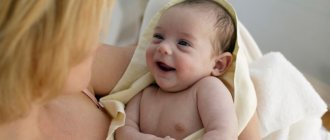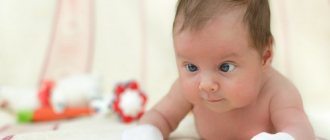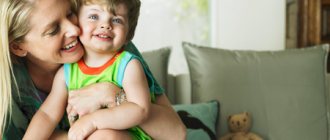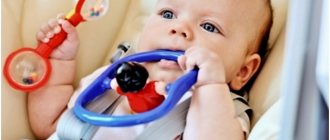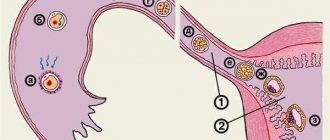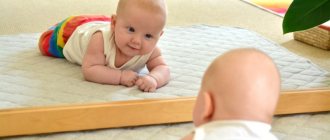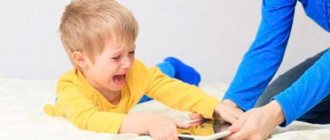Once born, a child actively begins to explore his surroundings. However, some factors may prevent this. Testing hearing in newborns without medical intervention at home is quite realistic and doable. Each parent can independently determine hearing impairment at any convenient time and, most importantly, exclude deafness.
Hearing Test Methods
To test the baby's ability to hear, their response to a specific sound is observed. A newborn baby at 1 month will react to it:
- active movement of legs and arms;
- freezing in an attempt to recognize a new stimulus;
- wide opening of the eyes;
- changes in breathing;
- waking up from sleep.
This seemingly simple procedure requires preparation—sufficient experience is needed to distinguish the child’s reaction to sound from the usual desire to move. If, when testing a baby's hearing, he feels unwell - his tummy hurts or the child has a cold, the test may be incorrect due to the fact that the baby is irritated due to discomfort.
In case of hearing impairment in children, early detection of pathology is the key to successful rehabilitation of the child, therefore, diagnosing the hearing level of newborns is constantly being improved.
All hearing testing methods are divided into three groups and their choice depends on the person’s age:
- computer audiometric examination;
- behavioral examination;
- gaming audiometry.
Computer diagnostics of hearing impairment makes it possible to most accurately determine changes in the body of a newborn child in the first month of life.
To study the sensitivity of hearing in newborns from several months to three years of life, the method of behavioral audiometry is appropriate.
Using the game method, it is possible to determine the quality of hearing in children from 36 months to five years.
Vision and hearing are formed in fetal development and improved in the first years of life. To monitor the development and acuity of hearing in newborns and identify abnormalities, pediatricians insist on checking its level by specialists, starting from the first days of life in the maternity hospital, then during periodic examinations.
At home, parents can monitor the development of hearing in newborns using well-developed techniques that do not require the use of special equipment.
Treatment of hearing loss in newborns
Hearing impairment in a newborn of any nature is identified based on the reasons that led to such a consequence. For minor deviations, they are limited to cleaning the ear canal and instilling anti-inflammatory drugs.
Children say! The grandmother promised to take her grandson to visit with the onset of summer, promising trips to the dacha to pick berries. And now summer has come, the child is with his grandmother. Danil (3 years old) does not obey. Grandmother: - Danya, if you behave like this, I’ll send you alone by bus to your parents. Danil, making the most innocent face: - Grandma, what about the berry? What about the machine?
If treatment is not effective, they resort to antibiotics and sometimes surgery if testing the newborn’s hearing gives a disappointing result. In combination with traditional medicine, traditional methods of treatment can also be used to treat hearing loss in an infant. The following few recipes are considered the most effective.
- Onion proportion. To prepare it, take a large onion, carefully remove the center and add a pinch of dill seeds. After this, bake the product in the oven until golden brown. Place the onion in cheesecloth and squeeze the juice out of it well. The resulting solution should be instilled into the newborn's sore ear, nine drops no more than four times a day.
- Medicine from cedar nuts. You will need one glass of peeled nuts. They are poured with one glass of vodka and infused for 40 days in a warm place, protected from light. However, such a remedy takes quite a long time to make, and in this matter it is impossible to delay.
- Alcohol and oil swab . For such a medicine you will need a 30% propolis tincture in alcohol and olive oil. Mix the components in a 1:4 ratio, wrap a tampon in the resulting solution, squeeze lightly and place it in the newborn’s sore ear for 12 hours.
With the correct selection of medications and folk remedies, there is a possibility of quickly getting rid of hearing loss, returning the child to his former life and normal development.
Hardware examinations
Screening allows you to accurately determine the impairment of a newly born child’s ability to hear while still in the maternity hospital. Based on the results of the procedure, the doctor can determine where changes have occurred in the child’s body that interfere with the perception of sound.
A correctly conducted examination and the professionalism of the doctor make it possible to accurately determine in which area of the auditory department the changes have occurred, and to build an effective and efficient treatment regimen.
The first screening examination is carried out before the child is discharged from the hospital during the first week of life. This examination is standard and is included in the newborn examination program.
Two different methods are used to examine children:
- study of the reaction of the auditory trunk of the central nervous system (according to the international terminology AVR);
- acoustic emission (OAE).
The test used to check the hearing of a newborn is selected based on the methodology used in the medical institution, the availability of equipment and the level of professional training of the doctor. Both methods do not injure the child and are accurate, but differ in the technology used. In some cases, the newborn may need to have both tests.
Assessing the Brain Response to Sound (ABR)
Using this method, the level of development of the child’s auditory system is determined by monitoring the level of the central nervous system’s response to sound vibrations, which are transmitted to the brain via the auditory nerve.
How is hearing tested using this method? Electrodes are attached to the baby's head and specially selected sounds are broadcast through headphones.
The program installed on the computer processes the received information and displays it on the monitor. The doctor can find out what the quietest sound is available to the child.
The telltale signal that allows you to identify hearing problems in children is a “click.” This is a combination that allows you to comprehensively test your entire hearing aid at the same time. If the sound transmission program records an adequate answer, the test is considered passed successfully. Screening takes up to a quarter of an hour.
Inner ear examination (UAE)
To check how the hearing aid itself reacts to sound, the otoacoustic emission method is used, which is determined using a special diagnostic device.
To obtain the correct result, the child must sleep. A device consisting of a speaker and a microphone is placed in the baby's ear. The sound is transmitted through the device to the brain, and another sound is generated in parallel, which is not transmitted along the nerve. This effect is called otoacoustic emissions.
The test computer program allows you to determine which sounds the child’s hearing aid responded to, the quality and quantity of these responses.
According to the test results, the child must respond to the intensity of sound, which makes it possible to distinguish quiet speech. Screening is carried out over 10 minutes.
Screening after birth
In the first days of life (usually after the second day) in the maternity hospital, all newborns undergo a special test - testing their hearing abilities or audio screening. A special device is used to record the response of hair cells to sound stimuli. The second screening examination is recommended to be carried out at the age of 1 month, 3 months, or six months.
It is difficult to say how reliable such a study is. If it provided the most accurate data, it would be possible to diagnose hearing pathologies within a year.
In the meantime, most cases of minor sensorineural hearing loss and unilateral hearing loss or deafness (if one ear cannot hear) are detected much later. That is, a child who has successfully passed audio screening may well turn out to be hard of hearing.
In the maternity hospital they use the delayed otoacoustic emission method . A portable device with a small, thin, flexible probe is called an audiometer. One part of the probe is placed in the baby's ear. The device sends sounds into the ear through a probe. Hair cells in the inner ear detect them and amplify them if the child hears them. If not, then the hair cells do not receive the signal, there is no impulse. To obtain more accurate results, it is considered optimal if the baby is fed and sleeping.
In the extract from the maternity hospital, if you look closely, you can find the following designations: D (+) = S (+). This means that the child was successfully screened for both the right and left ears. He hears.
If instead of pluses there is a minus, the screening showed the absence of a reaction of hair cells, and therefore the child will definitely be prescribed an additional examination.
Screening of premature babies has its own nuances. They undergo an acoustic examination not on the second day, given the immaturity of all organs and systems, including the hearing organs, but on any day after 2-4 weeks of life.
At risk for possible pathologies are children born to deaf or hard of hearing parents, as well as children born from a pregnancy during which the woman suffered from infectious viral diseases, especially if this happened in the early stages.
Research error
The methods have a number of erroneous results. ABR gives up to 4% false results, the simpler and faster UAE - up to 21% when tested in the first three days after birth. The reason for the discrepancy is the remains of intrauterine fluid in the baby’s ears, which block the passage of sound and create false deafness. In this case, a repeat test is scheduled in a week.
If the doctor suspects that the child suffers from certain hearing impairments, a full diagnostic examination is prescribed. As a result of a comprehensive examination, answers to the questions are given:
- whether the baby has hearing impairment or hearing loss;
- how much sensitivity to sound is reduced;
- whether the hearing loss is temporary or permanent.
Diagnostics is carried out using the ABR method using a wider range of stimuli and takes up to an hour.
Sofradex eye drops: indications, instructions, analogues
Pollution, infections, allergies are the most common causes of inflammation of the visual organs, which are accompanied by a lot of unpleasant symptoms and negatively affect visual acuity.
Sofradex eye drops are one of the most effective drugs that eliminate such phenomena.
Indications for use
The combined medicine Sofradex is widely used in the treatment of not only ophthalmological problems, but also otitis media. The components included in the drug help to quickly neutralize pain, itching, uncontrolled lacrimation, acute reaction to light and other main signs of infectious diseases of the eye organs.
In ophthalmic practice, drops are prescribed for:
- blepharitis (inflammatory processes developing along the edges of the eyelid or eyelids);
- different types of conjunctivitis;
- keratitis (inflamed corneas);
- iridocyclitis;
- eczema of the eyelids;
- barley;
- allergic reactions of a seasonal nature (to pollen, flowers, etc.), as well as to food, medicines, etc.
Sofradex eye drops have a bactericidal, anti-inflammatory and antiallergic effect.
Getting rid of serious eye infections - instructions for using Ofloxacin eye drops.
Eczema of the eyelids
Antibacterial drug of the fluoroquinolone group for topical use - instructions for Oftaquix eye drops.
Hearing test by parents
All parents should know how to test their newborn's hearing at home.
After birth, babies are not yet able to respond to quiet, low sounds and respond only to high and sharp ones. A child will be able to consciously turn his head in the direction of sound only by four to five months. If the child hears well, after six months he calls out to the sound and clearly turns his head in the direction of the source.
It is very difficult to determine that a baby is developing a hearing impairment in the first months of life - the baby can coo and coo, which misinforms inexperienced parents.
By 8-9 months of life, the child has the opportunity to become aware of sounds and try to reproduce their simplest combinations; the ability to speak at this age depends on hearing.
How does a baby's hearing develop by month from birth to one year?
The child’s hearing system will continue to develop, which means his sensory perception will also develop. This process is especially pronounced during the first year of a baby’s life, when each month can be considered a certain stage and milestone of development.
First month
In the first weeks, a newborn may notice sounds only at a short distance from him. Usually it is about one and a half meters.
In addition, he has a lot of work ahead of him - to master a unique sound vocabulary and remember the wide variety of sounds and noises of the surrounding world: the voices of people, the cries of birds, animals, various everyday sounds, like knocking on a door and creaking when it opens, the dripping and splashing of water, wind noise, traffic sound, etc.
In the first month of life, your baby hears:
- bright and clearly expressed sounds, especially in high tones - first he will freeze, listening, and then try to find their source with his eyes;
- If someone shouts next to the baby or some sharp noise is heard, he may blink in fear or open his eyes wide in surprise and shudder.
It is also possible that the Moro reflex will manifest itself - this means that the baby, in response to a strong sound, will spread his half-bent arms to the sides with his fingers spread out, and then move his arms in the opposite direction;
- hearing the mother’s voice next to or behind him, the child freezes, and at the age of one month he can turn his head in the direction of the sound;
- Now the baby's auditory concentration does not last long - he can listen only for five or ten seconds.
Help expand the child’s palette of sounds by talking to him affectionately and emotionally, reading fairy tales or telling poems, letting him listen to the sound of various melodies, songs, and toys.
You should not create an artificial atmosphere of silence in order to improve your baby’s sleep, because although he can hear during sleep, his hearing threshold is still slightly reduced, and besides, he also slept in your stomach surrounded by background noise.
Second month
In the second month, the child begins to distinguish not only high, but also low sounds, and can also pay attention to quiet ones. The time and range of his auditory perception and concentration gradually increases.
The baby can now wake up and cry if someone next to him makes noise or talks loudly. Now he is trying to learn to compare what he sees with the sounds he hears, which means that his visual and auditory reactions begin to interact in a complex, and a little later body movements will be added to them.
A very pleasant moment of this period - the baby can give you the first smile when you address him affectionately.
Third month
In the third month, the child no longer freezes when he hears any sound, but tries to orient himself in space and determine where it is coming from.
Motor reactions involved in combination with visual and sound perception consist of turning the head and trying to find the source of the sound with the gaze.
The baby not only listens to your voice with great pleasure, but also seems to listen carefully to what exactly you say. At the same time, he tries to focus his eyes on the speaker’s face, looking at it with interest and remembering it.
If you emotionally talk to your baby, he will definitely respond to you with active movements of his legs and arms, joyful humming, cooing and a happy smile, that is, the so-called revitalization complex will appear.
Fourth month
The baby quickly determines exactly where the sound is coming from. Now he reacts to different voices, to the song of a musical toy, and to the barely audible ringing of a telephone on the street.
The reaction to sound signals still takes a few seconds, but the child can already isolate any sound from the general noise stream and, having looked for the source, accurately turn his head towards it.
Also, the baby shows different reactions to the rhythm: if he listens to a lullaby or a calm melody quietly and almost without moving, then with dynamic, dance or fast music, he will noticeably perk up and, perhaps, even begin to move his arms and legs to the rhythm.
It is believed that at this time the child should already understand his name.
Fifth month
By five months, the baby begins to react to intonations in an adult’s voice.
For example, if you talk to him sternly or in a raised tone, the baby will frown and even cry, but if you speak in a gentle, calm voice, he will smile at you and walk happily.
He also becomes more attentive, sensing your mood: he laughs with his mother or worries and worries when you are angry or sad.
The child really enjoys communication. He reacts violently, starting to move energetically, cooing and babbling in response to you. He may even try to copy the movements of the one who is talking to him.
The baby can already distinguish the voices of his loved ones from the voices of strangers. Enjoys listening to music.
Sixth month
At six months, the child shows great interest in what you say and how you say it. In addition, he likes to listen to his own noise. He can actively imitate everything he hears and even conduct “dialogues.”
Now he can easily recognize by the intonation of your voice what exactly you want to express: prohibit something, praise or scold, ask.
Reacting to his name, the baby turns to the one who called him and smiles.
Musical and sound toys occupy him more and more. Now he plays with them with even greater interest, learning exactly how to produce sound: press a button, knock, shake an object, etc.
Seventh-eighth month
At this time, the child even hears your whisper and can react to it.
He can listen to the ticking of a clock, other everyday sounds at home and the sounds of the surrounding nature on the street, gradually replenishing and expanding his sound memory. His babbling becomes more meaningful and emotional, he pronounces many new sounds, as his speech function develops in parallel with his auditory function.
Ninth-tenth month
At nine months, a baby can imitate a wide variety of sounds: how a car drives, how a cat or dog talks, how waves rustle, etc. He also learns to distinguish between halftones and shades of sounds of different volumes.
Your child already understands and knows a lot. Now he can fulfill some simple request, for example, bring something to the word “give”, understands the words “no” or “no”, smiles if he is praised. If the baby needs something, he will now use his voice to get it.
You can often observe how children of this age play “conversation” among themselves or with their toys, communicating in a language incomprehensible to adults.
You shouldn’t stop this game, let the child develop, and then tell him the correct sound of the words he uses.
Soon a year
The development of speech directly depends on the formation and development of hearing. By the age of one year, the baby’s auditory analyzers become more subtle, and he is already able to comprehend what he heard and repeat.
Conscious words and simple phrases gradually appear in his speech. The child can sing along to his favorite songs and dance to rhythmic melodies. He knows not only his name, but also the names of his parents or loved ones, and if asked, he will show who is where.
Children can also point to named objects or parts of the body that are familiar to him, find an object by name or sound, can pronounce words in a whisper or quietly, and much more.
Moro reflex
The simplest technique is called the Moro reflex; it allows you to determine the presence of hearing in an infant and identify developed disorders, but does not give an idea of the level of sound perception.
To check your baby:
- laid on any flat surface, unswaddled;
- clap your hands strongly at a distance of 25-30 centimeters from the right ear, then from the left ear.
A child who hears well begins to move his arms and legs violently or cry in fear. If there is no reaction, the child must be seen immediately by a doctor.
Kalmykova method
A more complex technique was developed by doctor Kalmykova and involves the use of objects that create sounds of varying strength. For the manufacture of analyzers, identical plastic jars are used, one third filled in each house with semolina, buckwheat and peas.
2 people work with the baby - one plays with the baby, showing him a beautiful, brightly colored toy, the second shakes a can of cereal over the child’s ear at a distance of 10-15 centimeters. At each stage of verification, different banks are used. First use a container with semolina, then with buckwheat, and lastly with peas. Take a one-minute break between tests. In each period of development, the baby reacts to different intensity of sound - up to 6 months it is 70 decibels.
A normal child will be interested in a toy, but at the same time will react to the sound of a can of buckwheat and peas; if the reaction does not appear, this should alert the parents.
If a child is diagnosed with a hearing defect, this is not a reason to fall into despair. Modern methods of treatment and prosthetics allow such a child to be a full-fledged member of society.
